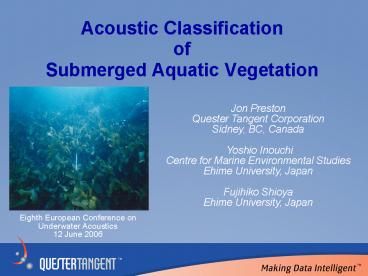Acoustic Classification of Submerged Aquatic Vegetation
1 / 16
Title:
Acoustic Classification of Submerged Aquatic Vegetation
Description:
Bozzano and Siccardi classified regions as dense, sparse, or bare by generating ... used genetic programming to classify backscatter from marine macro-benthos (2005) ... –
Number of Views:103
Avg rating:3.0/5.0
Title: Acoustic Classification of Submerged Aquatic Vegetation
1
Acoustic ClassificationofSubmerged Aquatic
Vegetation
Jon PrestonQuester Tangent CorporationSidney,
BC, Canada Yoshio InouchiCentre for Marine
Environmental Studies Ehime University,
JapanFujihiko ShioyaEhime University, Japan
Eighth European Conference on Underwater
Acoustics12 June 2006
2
Acoustic Classification ofSubmerged Aquatic
Vegetation
- Some previous work
- Acoustic segmentation
- Classification process, features
- Depth compensation
- Typical echoes from vegetation
- Bottom picking
- Echoes in the analysis window
- Results and seaweed maps
3
Mapping Seaweed and Macroalgae
Typical hardware
Single-beam vertical echosounder from a small
boat Usually not calibrated 200 kHz or more,
pulse length near 0.1 ms, beams wider than 5
Some previous work
- Chotiros and DeWitt found echo shape was more
effective for mapping than calibrated backscatter
(2000). - Bozzano and Siccardi classified regions as dense,
sparse, or bare by generating features, then PCA
and K-means clustering (1997). - Faghani et al separated species in seaweed
meadows by generating features and fuzzy logic
(2004). - Tseng et al used genetic programming to classify
backscatter from marine macro-benthos (2005).
4
Definition of Acoustic Seabed Classification
The organization of the seabed into discrete
units based on characteristics of its acoustic
response.
A phenomenological statistical approach is used
because the theory of high-frequency bottom
backscatter can be inverted only in rare
circumstances.
5
Acoustic Classification based on Features
Full Feature Vectors
Principal Components Analysis
Cluster
6
Features for Classification of Single-Beam Echoes
In QTC IMPACT and QTC VIEW, five algorithms
generate 166 features from stacked echo time
series.
7
Depth Compensation
Slope (ms/m) indicates spreading time of
insonification front
Echo Duration
from start of echo that fol-lowed the shortest
path
to end of volume scatter from last part of
transmit pulse.
Transmit pulse length plus echo extensions due to
penetration into volume and large-scale surface
roughness
8
Depth Compensation
As an example, use echo duration as the only
feature for classification.
Take threshold to be average duration over this
depth range (4.2 ms).
If shorter, classify as mud.If longer, classify
as gravel.
Classification correct for both over only 19 m
depth range.
Conclusion depth compensation is essential.
9
Depth Compensation
Continue to classify with echo duration only.
Reference depth 50 m.Mean echo duration from 50
m is 4.2 ms.
Compensate durations for depth linearly.
If shorter than 4.2 ms, classify as mud.If
longer, classify as gravel.
Classification correct for both over 82 m depth
range.
Conclusion linear depth compensation is adequate
in deep water.
10
Depth Compensation
Continue to classify with echo duration only.
Compensate durations for depth by comparison with
a standard echo length, SEL.
If less than 1, classify as mud.If more,
classify as gravel.
Classification correct for both over complete
depth range.
Conclusion SEL depth compensation is accurate in
all depths.
11
Echoes from an Area with Patches of Sargassum
Depth (m)
Screenshot from QTC IMPACT. Data recorded by
QTC VIEW 5.
12
Bottom Picking
Asterisks indicate bottom picks.
13
Analysis Window
Solid line echo Dashed line cumulative integral
For bare seabed
SEL in 100 samples Pick at sample 5
For seaweed
SEL in 32 samples Pick at sample 128
The analysis window contains the 256 samples of
echo amplitude from which features are
calculated.
14
Survey Area
Seto Inland Sea Japan
15
Classification Map
Sand 12 m
Eckolonia K 11 m
Eckolonia K 8 m
Eckolonia K 7 m
Sargassum F 5 m
Gravel 1 m
16
Classification Map
Acoustic classes shown as coloured symbols
Diver observations of percentage coverage of two
seaweed species shown as graphs.































